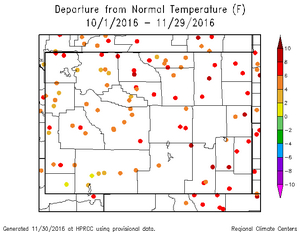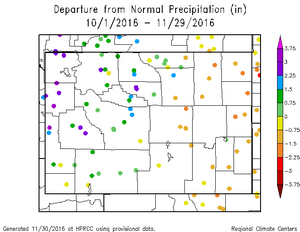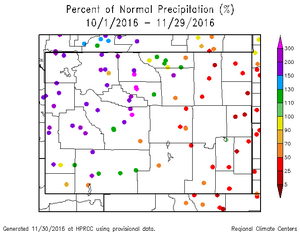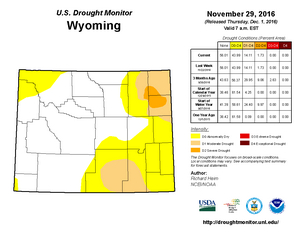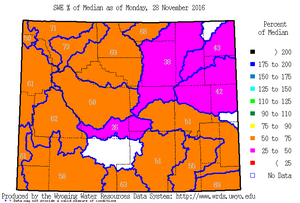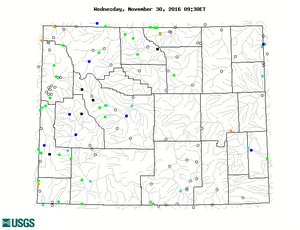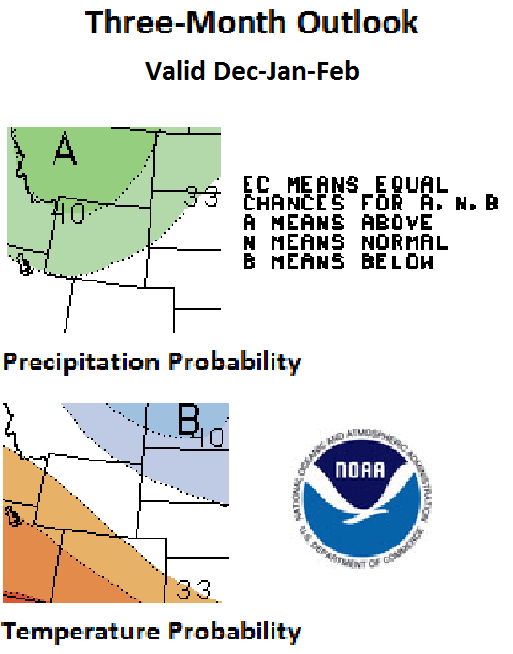 | |
 | |
| WRDS/SCO is currently working remotely so there may be a slight delay returning phone calls. Please email wrds@uwyo.edu if you are in need of information and we will respond as soon as possible |
|
| ||||||||||||
Drought Impacts and Outlook Summaries - November 2016View this Summary as a PDF
Highlights for the State
October was a warm month for Wyoming, with most locations 2°F to 8° above normal, and ranked as the 11th warmest since 1894. The eastern half of the state saw the highest anomalies with the southeastern part being in the 10 warmest Octobers. Climate Division 8 (Lower North Platte) had the 3rd-warmest October in the last 122 years. The western half of the state was a bit cooler but still was in the top third warmest Octobers on record. November has been even warmer than October relative to normal, with temperatures in most locations 6° to 12° above normal through the 28th of the month. The warmest conditions have been in the northern and eastern parts of the state. For statewide precipitation, it was the 20th wettest October since 1894. The northwest part of the state was much wetter than the east. Climate Division 2 (Snake River Basin) had the wettest October on record, and Climate Division 1 (far northwest corner of the state) had its 2nd-wettest October. In the east, Climate Division 7 (Niobrara and parts of Converse and Weston counties) had its 23rd driest October of the last 122. November.s precipitation (through the 28th) has been generally below normal except for a swath running southwest from Sheridan to Sweetwater counties, where precipitation has been 130-200% of normal.
Drought In the northwest, D1 has been removed from Park County, and D0 has been removed from Big Horn County and pulled back to the northwest in Park County. Conditions remain unchanged in the northeastern part of the state.
Snowpack Snowpack conditions become much more meaningful as the pack builds. Early in the season the median values are much lower, so a small change in the amount of snow water equivalent (SWE) can make a big difference percentage-wise when compared to that median value. That said, compared to the median SWE for late November, all basins are well below normal. Compared to last year at this time, only the Bighorn and Tongue basins are higher this year. Snow pack products can be found at: http://www.wrds.uwyo.edu/sitemap.html Do you have drought impacts to report? We still need your on-the-ground reports and you can input them here: http://droughtreporter.unl.edu/submitreport/
Water Resources The map below shows streamflow for October 20th compared to the historical average for this date.
Weather and Climate Outlooks Looking further out, the Dec-Feb period has the odds favoring above-normal temperatures for the southwestern half of Wyoming and better chances for above-normal precipitation for all but the southeastern part of the state. The Jan-Mar period has good chances for above-normal temperature for south-central and southwest Wyoming while precipitation is more likely to be above normal in the north and northwest parts of the state for the same period. There is less certainty when looking at the Feb-Apr period. This is, in part, a result of the weak La Nina pattern that is in play since Wyoming typically lays at the boundary area of its influence. The temperature outlook for that period thus has Wyoming with even chances of above-normal, below-normal, or normal temperatures. The outlook is for precipitation to be above-normal in the northern parts of the state. Drought conditions are expected to persist in the northeast and southeast areas of the state into 2017.
Heard around the State Weston County, Nov 4: Extremely dry. Livestock and wildlife depending on pipeline and water wells. Very dusty causing respiratory concerns with livestock. Laramie County, Oct 10: We are feeding more hay (horses) as the pasture growth has ground to a halt. We are also watering the lawn (buffalo grass), which is something we rarely do.
Partners
Stay Tuned and In Touch Live in or around the Wind River Indian Reservation? Check out the Wind River Indian Reservation and Surrounding Area Climate and Drought Summary at: http://www.hprcc.unl.edu/pdf/Wind-River-Climate-Drought-Summary_Sep16.pdf |
||||||||||||



